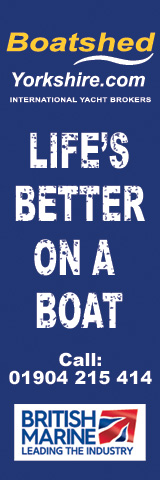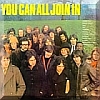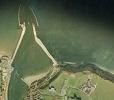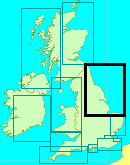You are viewing the expanded version of this Marina,
for faster browsing
use the regular version here
Whitby Harbour
Courtesy Flag
Flag, Red EnsignWaypoint
Safe Offing, Near N.Cardinal By. 54:30'.4 N 000:36'.65 WCharts
Admiralty 1612Rules & Regulations
"Slow" speed in HarbourHazards
Some Commercial Shipping, Entrance Dangerous in strong Onshore ConditionsTidal Data Times & Range
HW Dover +0500 MHWS 5.6m MHWN 4.3m MLWN 1.9m MLWS 0.8m (links)This site is designed for slower, roaming broadband connections, like you would get at sea, so it needs JavaScript enabled to expand the text.
General Description
Contacts
Harbour Office 01947 602354
Marina 01947 600165 VHF #11
Whitby pretty well drips with history, from the ruined abbey, through Captain Cook the prolific explorer and...... Dracula.
Bram Stoker set much of his novel here in Whitby, as those of us of a certain age who used to avidly watch Hammer horror films will know. In fact Whitby is a bit of a mecca for modern day "Goths" (you know, black clothes, weird big hair and scary make up), who descend on the place to purchase the Goth tat sold locally (and for the regular festivals). If you have any reluctant teenagers amongst your crew of this persuasion you'll have no trouble getting them on board for a trip to Whitby.
Captain Cook started his seagoing career in collier brigs (1746) moving coal between the Tyne and London.... later he went on to join the Navy, and it's interesting that his voyages of discovery were made in Whitby Collier Brigs... shallow draught, wide beamed, capable of sitting upright on the bottom, and tough....
Whitby was where James Cook started his apprenticeship, before becoming perhaps the most famous navigator of his times. He mapped Australia, New Zealand, Antarctica, and the South Seas. He is honoured by a large statue on top of West Cliff, and the Capt Cook Museum will be found at the harbourside.
The town perhaps reached its peak in the early 19th century when it was a centre for whaling and shipbuilding. By the late 19th century things were in decline...
For the visitor arriving by boat there will be plenty to explore ashore. Entry to the harbour is simple enough, but the place is best avoided in strong onshore winds. Once inside it is necessary to pass through a swing bridge before reaching the small council run Marina. This bridge swings on request on VHF#11 on the hour and half hour for two hours either side of HW.
Approach
Small craft should not attempt entry in strong onshore conditions....
.... from the north or the East, when dangerous breaking seas will be encountered.
Most directions of approach are clear of danger and straightforward... the exception to this is from the East and South East. When approaching from that direction a good offing is necessary to clear Whitby Rock and a shoal patch that extends outwards from the Abbey Cliffs just to the east of the harbour entrance. The extremity of this danger is marked by a northerly Cardinal buoy "Whitby" (Q), and if coming from the East this needs to be left on your port side.
Once making your approach from the region of this buoy you will need to take into account the tidal cross set... which could be pushing you eastwards into danger. A south-easterly set commences around two hours after LW Whitby. This continues until two hours after local HW at which point it turns and sets northwest.
Assuming that most craft will be approaching the harbour in the period approaching high water (in order to pass the bridge.. details later), the south-easterly set, which is likely to be considerable a couple of hours before high water, must be taken into account in the approach.
A quick glance at the chart will show the dangers laying down tide, with shallows and breaking seas.
Further Pilotage Directions...
A safer approach can be made from the north-west which is clear of danger.
It is unlikely that leisure craft will be entering at LWS but should the depths be a bit suspect there are leading marks to help you. These consist of an Upper Mark which is a White Circle with the Black vertical line, and the Lower Mark which is a White Triangle. These are located on the East side of the harbour just to the right of the tower of St Mary's church. When lined up (on a bearing of 169° T) these show the channel which is supposed to be maintained at 1.4 m below CD. This is carried through the two sets of piers.
A further set of trailing marks are mounted on the East Pier, you'll see them on your port hand side as you enter. These carry fixed Amber lights and need to be lined up astern (on a bearing of 029° T). This takes you towards the Fish Quay, where you will find more depth.
In planning your visit you need to be aware that the swing bridge through which you must pass to reach the Marina only opens on request on the hour and on the half hour for two hours either side of high water.
Visiting pleasure vessels waiting for a bridge opening can either tie up alongside the Fish Quay, (or a fishing boat) on the western side, or at the Fish Pier on the eastern side. Boats waiting here must remain manned at all times to facilitate fishing boat movements.
Whitby Marina should be contacted on VHF channel 11 before entering the harbour. If the Marina doesn't respond, your call may be answered by the Harbour Master or a watchkeeper. The Watchkeeper can also be contacted, subject to operational requirements, by telephone on 01947 602272.
The bridge can also be contacted directly on VHF channel 11, to arrange an opening at the times already specified. There are "Extra" Bridge Swings i addition to their standard times and these can be accessed at
http://media.visitmyharbour.com/MOB/Whitby-Extra-Bridge-Openings-2023.pdf
A link is provided below to the harbour authorities website:
Berthing, Mooring & Anchoring
Whitby Marina consists of a few pontoons laid along the River Esk.....
..... past the swing Bridge and before the fixed bridge. These can be clearly seen in the photos. The Marina operates on VHF channel 11, or telephone Whitby Marina: 01947 600165. The website is the same as already given. You can find a chartlet of the harbour HERE
More details including prices...
Visitors are moored at the north end of the pontoons on the Western side after passing the swing bridge and commercial docks (again on the Western side). You should expect to have to raft or be rafted upon so rig fenders accordingly
Larger vessels may be moored on Endeavour Wharf by the harbour master. All vessels are only allowed to stay 14 days max, and rafting out 2 deep maximum is the norm.
Charges have been simplified since we last updated and now (2022) are a simple £2.22 +VAT per metre per night with a minimum charge of £17.80 + VAT so for a 10m boat you're talking £26.64 per night.
Facilities
Water and electricity are available on the pontoons, with the electricity operated by pre-paid token.
Toilets, showers and laundry are taken care of in the ablutions block (co-located with the Marina Office at the top of the pontoon access bridge) with access via key code, and the laundry operated once more by tokens.
Sewage pump out (tokens), and chemical toilet waste disposal can be provided. The authorities ask that you don't use the your marine heads while in harbour.
Small quantities of diesel by Jerry can are available adjacent to the Marina office, and security is handled by locked gates to the pontoons.For petrol you will have to hike up the hill towards the West Cliffs.
Trailer Sailers can use the slipway at Whitby Marina which has access at about half the tidal range, and daily fees of £12.60 inclusive of harbour dues and VAT. Remember the swing bridge.
Chandlery is available virtually on site (They do both Calor and camping gas refills), and a large supermarket will also be found nearby. The town centre and railway station are again close by, with the railway connecting to Middlesbrough. The Yorkshire coastliner bus also serves Whitby. The town is surrounded by the North York Moors National Park and is a good base for exploring.
The old town is on the eastern side of the River, with access to the ruined abbey. Here you will find narrow streets with interesting shops (can get very crowded at bank holidays), and also the Whitby Yacht Club at their centrally located premises overlooking the lifeboat house at the Pier. Visiting yachtsman are welcomed here, check out their website below:
http://www.whitbyyachtclub.com/
Digging around a bit in the old town you will discover the Dracula " experience" at the Harbourside, Dracula walking tours around the town, plus lots of Goth gear for enthusiasts (although not very practical on the foredeck when it's blowing a hoolie !)
The Western side is where the main town is located, and following along the Harbourside will bring you to a very good selection of fish and chip shops, plus ice cream, amusements etc.
Visitors to Whitby without boats will find plenty of opportunities to get on the water from the old lifeboat to an imitation pirate ship.
All in all acceptable boat facilities, excellent holiday town facilities.
History
Whitby is a town and civil parish in the Scarborough district of North Yorkshire on the north-east coast of England. Nowadays it is a fishing port and tourist destination. It is situated 47 miles (76 km) from York, at the mouth of the River Esk and spreads up the steep sides of the narrow valley carved out by the river's course. At this point the coast curves round, so the town faces more north than east. According to the 2001 UK census, Whitby parish had a population of 13,594.
History
Many interesting fossils have been found in the Whitby area including entire skeletons of pterodactyls. Whitby is known for its well preserved ammonite fossils, which can be found on the seashore or purchased from stalls or shops in the town.
Three green ammonites are featured on the coat of arms of the Whitby Town Council. These ammonites are shown with a head carved on, as "snake stones", which were sold as religious souvenirs in memory of Saint Hilda of Whitby.
Early-medieval Whitby
In about 656, Oswiu or Oswy, the Christian king of Northumbria, fulfilled a vow by founding a monastery there.
Faced in 655 with the mighty army of Penda, the pagan king of Mercia, which greatly outnumbered his own, Oswiu asked God to grant him victory, promising to consecrate his infant daughter Ælflæda to the service of God and to give land to found monasteries. Penda and most of his nobles were killed in the battle. Oswiu honoured his pledges by granting 12 small estates of 10 hides each in various places for monasteries to be built. One of them was at Streanæshealh, later known as Whitby Abbey. This was the house that Ælflæda herself entered as a pupil and of which she later became abbess.
The first abbess was Hilda, a remarkable figure, later venerated as a saint. Under her influence, Whitby became a centre of learning, and the poetry of Cædmon is amongst the earliest examples of Anglo-Saxon literature. It was the leading royal nunnery of Deira, and the burial-place of its royal family. The Synod of Whitby, in 664, established the Roman date of Easter in Northumbria at the expense of the Celtic one, an important and influential decision.
In 867, Danish Vikings landed two miles west of Whitby at Raven's Hill, and moved on to attack the settlement and to destroy the monastery. It was only after the Norman Conquest of 1066 that William de Percy ordered that the monastery be refounded (1078), dedicating it to St Peter and St Hilda. Later it became Presteby (meaning the habitation of Priests in Old Norse) then Hwytby; next Whiteby, (meaning the "white settlement" in Old Norse, probably from the colour of the houses) and finally Whitby.
Late-medieval and Tudor periods
According to Langdale's Yorkshire Dictionary (1822) and Baine's Directory of the County of York (1823), even up to the reign of Elizabeth I Whitby was little more than a small fishing port. In 1540, it had consisted of only around twenty to thirty houses and had a population of about two hundred inhabitants. In that year Henry VIII dissolved the monasteries, including Whitby Abbey.
At the end of the 16th century, Thomas Chaloner of York travelled to Italy and visited the alum works in the Papal States. He recognised that the rock from which the alum was made was identical to that abundant in several areas in and around his Guisborough estate in North Yorkshire. Alum was a very important product at that time, used internationally, in curing leather, fixing dyed cloths and for medicinal uses. Up to this period the Vatican had maintained a virtual monopoly on the production and sale of the product.
Chaloner secretly brought some of the Pope's workmen to England to develop a thriving alum industry in Yorkshire. (It is said that this significantly lowered the international price of alum, impacting the profitability of a traditional source of revenue for the Vatican, and that Chaloner was excommunicated).
Over the centuries, the town spread both inland and onto the West Cliff, whilst the East Cliff (sometimes called the Haggerlythe) remains dominated by the ruins of Whitby Abbey and St Mary's Church. The way into the interesting ruined Abbey is through the historic Banqueting House alongside. The Abbey is owned by English Heritage, which restored the Banqueting House to contain exhibitions and museum displays about the Abbey and Whitby and opened it in 2002.
The East Cliff is at quite a distance by road, the alternative being to climb the famed 199 steps. Many who make the climb can be heard counting on the way up. 2005 saw the completion of the first major restoration of the 199 steps since the 19th century. To raise funds, each step was offered for sponsorship at £1,000, which was raised from visitors as well as locals. The project culminated in a service at St Mary's Church on Sunday 1 October 2005. A commemorative book, available on request at the church, contains a page dedicated to each sponsor.
Several alum producing centres were established close to Whitby including, in 1615, one near Sandsend (now Sandsend Ness) three miles from the town. Two new industries thus arrived in the port of Whitby—the transport of alum and that of the coal used in its production.
Whitby thereby grew in size and wealth, extending its activities to include shipbuilding, using the local oak timber as raw material. Taxes on imports entering via the port raised the necessary finance to improve and extend the town's twin piers, thereby improving the harbour and permitting further increases in trade. (They are working piers, not the variety which caters elsewhere to holidaymakers.)
In 1753 the first whaling ship set sail from Whitby to Greenland. This initiated a new phase in the town's development, and by 1795 Whitby had become a major centre for the whaling industry.
George Hudson completed his railway network connecting Whitby and the towns of the East Riding with York in 1839. It is thought to have played a vital part in the development of Whitby as a tourism destination. George Hudson was also responsible for building or, rather, half-building the Royal Crescent. Plans to complete the project were abandoned due to insufficient funds. The Crescent still remains a popular tourist attraction.
Whitby was the site of the Rohilla disaster of 30 October 1914, when the hospital ship Rohilla was sunk (either by running aground, or hitting a mine; accounts differ) within sight of shore just off Whitby. Eighty-five people lost their lives in the disaster; most of them are buried in the churchyard at Whitby.
Also in 1914, Whitby was shelled by German battlecruisers Von der Tann and Derfflinger, aiming for the signal post on the end of the headland. Scarborough and Hartlepool were also attacked. Whitby Abbey sustained considerable damage during the attack, which lasted only 10 minutes. The attack on Whitby was the final assault on the Yorkshire coast. The German squadron responsible for the strike was able to escape without capture despite an attempt made by the Royal Navy. The Navy reported poor visibility and signalling as a determining factor.
Present-day Whitby
The modern Port of Whitby, strategically placed for shipping to Europe, with very good proximity to the Scandinavian countries, is capable of handling a wide range of cargoes, including grain, steel products, timber and potash. Vessels of up to 3,000 tonnes DWT are received on a routine basis at the Wharf, which has the capability of loading/unloading two ships simultaneously. 54,000 square feet (5,000 m2) of dock space is currently (2004) allocated for storage of all-weather cargo and a further 17,000 square feet (1,600 m2) of warehouse space is reserved for weather-critical goods storage.
The town is served by Whitby railway station which forms the terminus of the Esk Valley Line from Middlesbrough, formerly the northern terminus of the Whitby, Pickering and York line. Whitby is also served by the Yorkshire Coastliner bus line, which can take travellers to and from Leeds, Tadcaster, York, Scarborough, Bridlington, Pickering, Malton and many more towns in Yorkshire.
The town was awarded "Best Seaside Resort 2006", by Which? Holiday magazine.
Whitby has a fish market on the quayside which operates as need and opportunity arise. The ready supply of fresh fish has resulted in an abundance of "chippies" in the town, including the Magpie Cafe which Rick Stein has described as the best fish and chip shop in Britain.
West Cliff has its own landmarks — a statue of Captain James Cook, who sailed from the town, and a whalebone arch, commemorating the once large whaling industry. There is also a new science museum — Whitby Wizard. The whalebone arch is the second to stand on this spot; the original (a larger version) is now preserved in Whitby Archives Heritage Centre. By the inner harbour, next to the tourist information office, there is also a statue commemorating William Scoresby, inventor of the crow's nest.
One unusual feature of Whitby is the Dracula Museum. Part of Bram Stoker's famous novel was set in Whitby, describing Dracula's arrival in Britain on a ship washed ashore in the harbour, and how Lucy watched from the churchyard as the sun set over the nearby headland of Kettleness, but did not know how many steps she climbed to get there. Stoker's story incorporated various pieces of Whitby folklore, including the beaching of the Russian ship Dmitri, which became the basis of Demeter in the book. Furthermore, it was at the public library in Whitby that Stoker discovered the name "Dracula."
Events
Whitby Regatta occurs once a year for three days in August. Originally a local rowing competition, over the years it has expanded to include events such as a large fair stretching down the pier, police demonstrations, fireworks and military displays - including the spectacle of the Red Arrows, provided that the weather is good.
Whitby also hosts the bi-annual Whitby Gothic Weekend, a festival for members of the Goth subculture.
The text on this HISTORY page is covered by the following licence
http://en.wikipedia.org/wiki/Wikipedia:Text_of_the_GNU_Free_Documentation_License
Eating, Drinking & Entertainment
Being a major holiday centre the visiting yachtsman will find no lack of establishments offering food and drink. How about over 20 pubs for starters...
These articles are not meant to be a tourist guides, so as is our habit, we will leave you with a couple of links for your further investigation:
Pubs:
http://www.beerintheevening.com/pubs/results.shtml/el/Whitby%3BNorth%20Yorkshire/
Restaurants:
Links
|
Do you have a comment to make about Whitby or it's marinas ? Did you find this coverage helpful ? HAVE YOUR SAY (your email address will always be kept private)
Your Ratings & Comments









